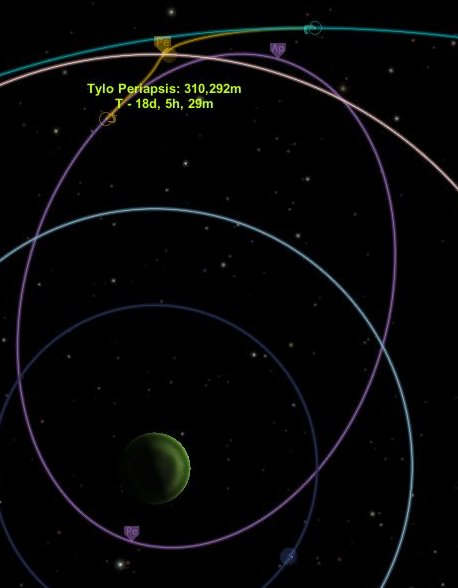Difference between revisions of "Tutorial: Gravity Assist/zh-cn"
(Create zh-cn Page) |
|||
| Line 1: | Line 1: | ||
| − | [[File:Gravitational slingshot.svg|right|thumb|200px| | + | [[File:Gravitational slingshot.svg|right|thumb|200px|引力弹弓效应的极简模型:飞船速度可以得到2倍行星自转速度的叠加]] |
| − | + | 重力助推是一种非常节约燃料的加速(或减速)机动方式。这种机动就是,当位于天体的引力范围球体之内时,它会对飞船产生一定的牵引力,从而相应为飞船产生加速(或减速)的效果。当你飞离某颗行星,如果它带有卫星,那么我们就可以利用该卫星进行重力加速机动,从而节约大量的燃料。 | |
| − | *''' | + | *'''长度:'''30分钟 |
| − | *''' | + | *'''难度:'''适中 |
| − | *''' | + | *'''对应版本:'''0.18.4 |
== How to do it == | == How to do it == | ||
Revision as of 01:57, 24 June 2013
重力助推是一种非常节约燃料的加速(或减速)机动方式。这种机动就是,当位于天体的引力范围球体之内时,它会对飞船产生一定的牵引力,从而相应为飞船产生加速(或减速)的效果。当你飞离某颗行星,如果它带有卫星,那么我们就可以利用该卫星进行重力加速机动,从而节约大量的燃料。
- 长度:30分钟
- 难度:适中
- 对应版本:0.18.4
How to do it
In this example we will leave from Kerbin to a trajectory to Duna by performing a gravity assist around the Mün. Usually you need to raise your apoapsis to 85 million km to escape from Kerbin. With this method we will just have to get to the Mün orbit (12 million km). This will save you fuel for several hundred m/s of delta-v.
- Get your ship into a circular Low Kerbin Orbit
- Zoom out so you can see the orbit of Kerbin around the sun.
- Arrange for a fly-by with the Mün just like you learned in the "Going to the Mün" ingame tutorial, but arrange for it to happen while the mün is heading into the direction you want to go. In this case we want to get further way from the sun, so do it when the Mün is going in that direction - the moment it intersects the orbit of Kerbin.
- Accelerate time until you reach the sphere of influence of the Mün
- Now plan another course correction maneuver. The maneuver is more effective when you are close, so try to pass the Mün as close as possible without colliding. Your Mün periapsis needs to be behind Mün on Müns trajectory. When you pass in front of Mün, you will lose speed instead of gaining it. Also watch the declination of your trajectory - when it gets too high it will be problematic.
- Accelerate time until you left the SoI of the Mün.
- When you check the map you will notice that you are on a much wider orbit than you were before the Mün fly-by (likely with an apoapsis beyond Minmus orbit), but it's not a Kerbin escape trajectory yet. The Mün hasn't yet given you all the speed it can.
- So perform another correction maneuver which leads you to another close Mün fly-by and again try to pass it as close as possible.
Congratulations, you should now be on an orbit leading you in the general direction of Duna with plenty of fuel left for the return trip. When you want to go back, perform the same trick with Ike.
Reverse Gravity assist
Should you enter the Duna-Ike system in a suitable trajectory, you can perform a reverse-gravity-assist to lose speed instead of gaining it. To do so just do an Ike-fly-by. In order to lose speed instead of gaining it, your Ike periapsis needs to be in front of Ike's trajectory instead of behind it.
Powered Gravity assist
To get even more out of a gravity assist, you can perform a powered gravity assist. As you know, accelerating at your periapsis has the greatest effect on your apoapsis. This still applies to your periapsis during a gravity assist. When you accelerate during your fly-by, this fuel is used very efficiently to increase the apoapsis of your final trajectory. This is, however, a very difficult technique, because it is hard to control your final trajectory, even when using a maneuver node.


